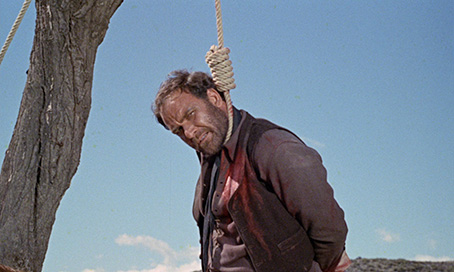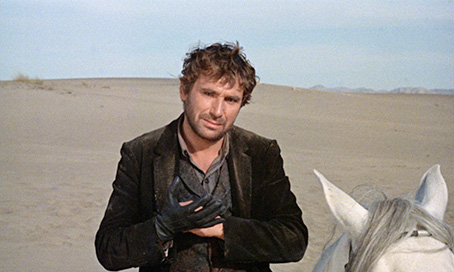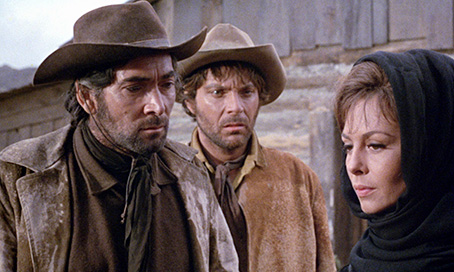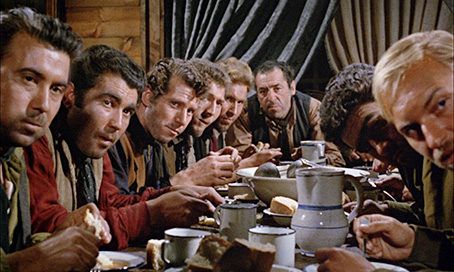|
I've already covered my niggling reservations about the term 'Spaghetti Western' in my review of Sergio Sollima's superb 1967 Faccia a faccia [Face to Face], while at the same time accepting that it's long since become part of the lexicon of film and specifically genre definition. The spaghetti western is technically a sub-genre, sharing codes and conventions with the western but having its own specific motifs and stylistic tics. As the term somewhat condescendingly suggests, the films in question tend to be Italian in origin, but were almost always set (though rarely filmed) in the American West and often featured American actors in principal roles. In the way that these things go, the international success of these films saw elements of this particular brand of western seep their way into this once very American genre, fuelled in no small part by spaghetti western superstar Clint Eastwood's return to home soil and subsequent move into the director's chair. But a French spaghetti western? Surely not? Oh, you'd better believe it.
The 1969 Cemetery Without Crosses was directed by French born actor and filmmaker Robert Hossein, who also plays the leading role of moody and taciturn gunslinger Manuel. Clearly a fan of Italian westerns – this film carries a dedication to Sergio Leone, with whom Hossein was friends – he has with co-screenwriter Claude Desailly* fashioned his own dark and downbeat take on the spaghetti western formula. The original title was Une corde, un Colt..., which literally translates as 'A rope, a colt...' and it first arrived on western shores as The Rope and the Colt, a pertinent title quoted from the main theme song, one sung by none other than the great Scott Walker. Yes, this film has class from its opening credits, which play out in black-and-white as three brothers Ben, Thomas and Eli Caine are chased across a barren landscape by members of the powerful Rogers family. As the titles conclude and the film dissolves to colour, the spineless Thomas and Eli ride off and leave the exhausted and injured Ben to make his way back to the family ranch. The Rogers, however, are hot on his trial and just seconds after he has fallen from his horse, they've hauled him back on it, thrown a rope round his neck and hanged him, despite the anguished cries of his wife Maria.

After burying her husband, Maria rides out to an isolated ghost town that has only one inhabitant, the aforementioned Manuel, who passes his time whittling or playing roulette against himself in the town's otherwise ramshackle bar. She has the cash to hire him to avenge her husband's death but he initially turns her down. He's through with fighting he assures her, at least that's what he says on the English language track – in common with its Italian brethren, Cemetery Without Crosses was post-dubbed both in English and Italian, and the dialogue is often somewhat different on each. I'll get to that later in the Sound and Vision section. Anyway, it's clear that Maria and Manuel have a history, and when Maria walks away, seemingly unconcerned what will happen to her should she attempt to right this wrong on her own, Manuel loads his pistol, tests his still keen reflexes and heads towards town.
It may sound like a bit of a vanity play to cast yourself as the icy cool lead in your own film, but Hossein the director and actor create in Manuel a character who fits the iconic lone gunslinger role as if born to it. Dressed in worn clothing and sporting just enough of a beard to suggests he cares little what others think of his appearance, he carries a single Colt .45 revolver on his right hip, which he draws with his left hand and fans with his right, onto which he pulls a single black leather glove just before he intends to start shooting. It's a neat character trait that builds anticipation by signalling when Manuel is about to make his move, and at one point is even employed to diffuse potential conflict by informing his opponents of his deadly intentions.
Cemetery Without Crosses is a revenge western in which the act of vengeance brings few of the traditional cathartic pleasures and is ultimately shown to be a destructive and potentially endless cycle. It lays out its (sub-) genre credentials in the opening scene, but confirms them when Manuel steps into a fight between the Rogers boys and four armed landowners that they have wronged, and instead of joining forces with the landowners as expected, Manuel shoots three of them dead and walks away. He calmly accepts arrest, then waits in his jail cell for the Rogers boys to spring him – the sheriff, of course, is on their payroll – and on meeting their father is promptly hired as their new foreman. Could it be coincidental that the father shares his name with one of the most famous Western stars of the silent era? Nah, I didn't think so either. Just what Manuel has planned for the Rogers family should frankly be left to the film itself to reveal. In true spaghetti western fashion, regular notions of morality take a bit of a hike here, but even allowing for that I wasn't quite ready for the string of dark turns that the story later takes. I can say no more, but do not expect to come out of this one wearing a triumphant smile.

If Hossein the actor delivers the genre goods as the brooding Manuel, as director he meets and frequently exceeds expectations. Peppering his cast with faces you'd need to be assured were French to realise they were not members of an Italian western stock company, he creates the look and feel of the spaghetti westerns of the day with uncanny accuracy, the only giveaway being the use of the 1.66:1 ratio that was then the French standard rather than the genre's preferred 2.35:1 scope frame. Where Cemetery Without Crosses stands apart from its Italian colleagues is in the strikingly minimalist nature of much of its storytelling, with dialogue kept to a functional minimum and whole sequences playing out with hardly a word exchanged. This peaks in a midsection set primarily in and around the ghost town bar that Manuel has made his home, a nine minute sequence in which major plot points unfold without a single word spoken and everything we need to know supplied through expressions, gestures, body language and Hossein's carefully selected camera angles. It's a remarkable demonstration of Hossein's skill as a visual storyteller (though let’s not underestimate the considerable contribution made by composer André Hossein, the director’s father) that climaxes with Manuel and Maria facing each other in the wind-swept street outside, their personal history and regrets written all over their faces. I can say no more without stomping headlong into spoiler territory, but you'll certainly know the scene I'm referring to when it comes.
There's a fatalism to the film and specifically to Manuel that on a second viewing is clearly evident from the early stages. From his first appearance he comes across as the physical embodiment of the end of an era, a tattered symbol of the dying days of gunfighters who are soon to be swept aside by new notions of what constitutes progress and civilisation. He's a compelling creation well served by a film that draws inspiration from the Italian westerns its director so admires, and while tonally darker than just about all of them, it's one of the most stylish, thoughtful and satisfying examples of a genre in which it was technically an outsider.
Those of you familiar with Arrow restorations (that's all of you, right?) might do a bit of a double-take 18 minutes into the film when Manuel first rides into town and the image is hit by a blizzard of what looks like chemical damage, the climax of a number of less aggressive signs that elements of the source material may be beyond repair. As you would expect, Arrow are completely up front about this in the accompanying booklet, revealing that the internegative used for the restoration has "suffered from occasional damage in the form of density fluctuation, scratches and debris, and instances of chemical stain" and that this new presentation "exhibits occasional instances of this damage, in keeping with the material's condition." Notice the key word there, 'occasional'. That snowstorm of damage lasts only a few shots, and while there is a very faint flicker and a hint of jitter to the picture in places, plus a couple of shots that are not quite as crisp as the others, the rest is in solid shape and frequently shines. At it's best the transfer is seriously impressive, with a well balanced contrast range and the sort of crisp detail that leaves you in no doubt that you put a Blu-ray in your player and not a DVD. The colour intensity does vary a little, being seemingly bolder indoors than out in the sun, although this may be down in part to the lighting and decor. It's also worth noting that we're seeing the result of a major clean-up that has removed thousands of instances of dirt and light scratches, again the work of Deluxe in London under the supervision of James White. Despite those small flaws, I'm betting this is as good as the film looked since its initial release.

The Linear PCM 2.0 mono soundtracks – one English, one Italian – are both in decent shape, with next to no background crackle or hiss. That the dialogue and music have a treble bias, no real bass and a narrow dynamic range should come as no surprise for a film of this age and origin, and thus be no cause for legitimate complaint.
As stated above, there are two soundtrack options available here, English and Italian, both of them dubs and both most appropriate to the sub-genre in which the film comfortably sits. The surprise, perhaps, as that there is no French language version, given that the majority of cast hail from France and probably performed their roles in their mother tongue. You could argue, of course, that this would effectively shatter the illusion that that Hossein has so carefully crafted, that Cemetery Without Crosses is very much part of a genre with a distinctive Italian identity, and the decision to provide only English and Italian dubs may well have been his intention from the start. As someone who discovered this particular breed of western through English language versions of Sergio Leone's Dollars trilogy, the fact that the voices don't quite match the movements of the characters' mouths is par for the course and something I've long since become comfortable with. The problem with dubbing any film in more than one language, however, is that what may take ten syllables to say in Italian may take between five and fifteen to deliver in English, and thus in order to make the words fit in the available space, the dialogue will often differ from dub to dub. As a result, watching Cemetery Without Crosses with the English track is a slightly different experience to watching it with the subtitled Italian track in more than just the music of the language, as the dialogue is changed enough to alter how exchanges play out and even to some degree the motivation of characters. Check out this exchange between Maria and Manuel following her request that he avenge her husband's death.
| |
English language track |
English subs on the Italian track |
| Manuel: |
"I can't help you." |
"I've given up shooting." |
| Maria: |
"Well I suppose I've got to do it
all alone." |
"But that has always been what you do." |
| Manuel: |
"That's right." |
"Not any more." |
| Maria: |
"Then you won't." |
"Start again." |
| Manuel: |
"Doesn't interest me." |
"And why should I?" |
| Maria: |
"Then maybe you're willing to do
it for a price." |
"You're the only one who can stand up to the Rogers." |
| Manuel: |
"Don't bother to bring it up. You're wasting time." |
"Now you remember me. It's too late." |
| Maria: |
"I already brought it up. This is
what Ben got back from the Rogers." |
"Then do it for this, it's Ben's share." |
| Manuel: |
"I'm through with fighting." |
"I'm not interested in money." |
| Maria: |
"Not even for me?" |
"Then do it for me." |
| Manuel: |
"Not even for you." |
"What if I don't?" |
| Maria: |
"You were my last hope. There's
only myself now." |
"I'll manage on my own. I know what I have to do." |
| Manuel: |
"They'll kill you." |
"They'll kill you." |
| Maria: |
"Let 'em, then." |
"Too bad." |
| Manuel: |
"Why don't you get out while
there's still time?" |
"Come back in two days." |
As you can see, the overall thrust of the dialogue is the same, but there are subtleties in the choice of words that do make a difference. Which is the more accurate to Hossein's original intention I wouldn't like to say.
Optional English SDH subtitles are also available for the English language track.
Remembering Sergio (5:19)
A too brief but still enlightening new interview with Hossein, who provides a bullet point outline of how the film came together, regrets missing the chance to act in a Sergio Leone film (he was supposed to appear in Once Upon a Time in the West) and reveals that the Rogers family meal sequence (see grab below) in Cemetery Without Crosses was actually directed by Leone.

Location Report (7:57)
An extract from the French television programme Cinéma from 1968, this is a short but still seriously valuable grab, giving us a brief peek at Hossein the director working with his actors on location in Spain. Hossein himself is interviewed and describes the film as being "like a Shakespeare tragedy but in the form of a western," as good a summing up of its tone as I've heard. The unseen interviewer also briefly chats with lead actress Michèle Mercier, and there's a longer talk with actor Serge Marquand, who plays Larry Rogers and here is laid up with a broken leg, presumably from an unspecified accident on set. "From what I can see," he says as the camera pans across from his plaster cast, "being a cowboy is no laughing matter."
Archive Interview with Robert Hossein (2:25)
Another brief monochrome snippet, this one from the French television programme Côte d'Azur Actualités, in which Hossein is interviewed in Monte Carlo about his intentions and motivation in making what the interviewer claims is the first French western. He may be right.
Trailer (3:49)
The original Italian trailer, narrated in a somewhat literal fashion ("He knew this ugly business might cost him his life – he had to be clever about it") but cut to give a flavour of the action without giving too much away.
Booklet
A typically well produced booklet kicks off with an excellent essay by Ginette Vincendeau on the film and its strengths as both a western and an example of unfairly overlooked French cinema. This is followed by an enthralling piece on movie-loving singer Scott Walker and the evolution of the film's title song, which Walker sings. Credits for the film and detailed notes on the restoration are also included.
A downbeat but gripping and impressively directed Gallic take on the spaghetti western, one I'll admit I wasn't even aware of before this release but have since been enthusing about to all of my friends (yep, they're almost all genre fans too). That some of the damage on the source material is too extensive to repair is something we'll just have to live with, and in all other respects this is another first class release from Arrow Video. Recommended.
* Although Dario Argento is also credited as co-scriptwriter, Hossein later claimed that he actually had no hand in the script and his name only appears on the Italian version of the film, making me wonder if it was he who shaped the Italian dialogue.
|